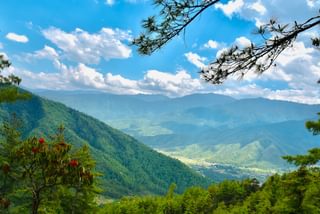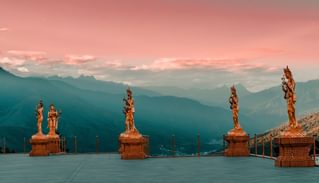Best time to visit Bhutan
A month-by-month guide
Bhutan, nestled in the eastern Himalayas, offers a diverse range of experiences throughout the year. The best time to visit depends on your interests, whether you prefer trekking, cultural exploration, or witnessing the stunning beauty of its landscapes.
Spring (March to May):
Peak Season: Spring is one of the most popular times to visit Bhutan. The weather is mild and pleasant, and the landscape awakens with blooming rhododendrons and wildflowers.
Trekking: Many high-altitude trekking trails open, such as the Druk Path Trek and the Jomolhari Trek. The clear skies provide excellent mountain views.
Cultural Festivals: Spring hosts various vibrant festivals like Paro Tsechu, providing insights into Bhutan's rich culture.
Summer (June to August):
Low Season: Summer in Bhutan brings occasional monsoon rains, making it the low season for tourism. However, this season offers lush green landscapes and fewer crowds.
Trekking: Lower-altitude treks like the Gangtey Trek are accessible. Monsoon rains may affect higher-altitude trails.
Cultural Exploration: You can still explore monasteries and temples, but be prepared for occasional rain showers.
Wildlife: Bhutan's national parks are teeming with wildlife, and this is a great time for birdwatching.
Autumn (September to November):
Peak Season: Autumn is one of the most favorable times to visit Bhutan. The weather is comfortable, and landscapes are vibrant with autumn foliage.
Trekking: High-altitude treks, like the Druk Path Trek and the Bumthang Owl Trek, are at their best with clear skies and pleasant temperatures.
Cultural Festivals: September and October host various cultural festivals, including the Thimphu Tshechu and Jambay Lhakhang Drup.
Winter (December to February):
Low Season: Winter brings cold temperatures, and higher-altitude treks are limited. However, it offers a unique winter experience with snow-capped mountains and cultural festivals.
Trekking: Lower-altitude treks like the Punakha Winter Trek are possible, offering a different perspective of Bhutan's winter beauty.
Cultural Festivals: Some monasteries host winter festivals, and Bhutan celebrates festivals like the Trashigang Tshechu and Trongsa Tshechu in December.
Winter Scenery: Bhutan's winter landscapes, complete with snow-capped mountains, create a picturesque backdrop.
Bhutan's festivals, known as "tshechus," are a highlight throughout the year. These festivals feature colorful mask dances, traditional rituals, and cultural performances, offering a unique opportunity to immerse yourself in Bhutan's rich traditions. The Paro Tsechu in spring, Thimphu Tshechu in autumn, and various others in between are worth experiencing.
In summary, the best time to visit Bhutan largely depends on your preferences. Spring and autumn are peak seasons, offering a balance of pleasant weather, trekking opportunities, and cultural richness. Winter and summer, despite being low seasons, provide unique experiences, from winter wonderlands to lush green landscapes. Plan your Bhutan visit accordingly to make the most of the season that aligns with your interests.

January
In January, Bhutan experiences its winter season, with varying temperatures. The country's snow-covered landscapes, including iconic sites like Paro Taktsang and Punakha Dzong, provide picturesque scenes for photography. While higher-altitude trekking trails are closed, lower-altitude options like the Druk Path Trek are still accessible. Bhutan offers vibrant festivals such as the Punakha Dromchoe and Tshechu, showcasing masked dances and cultural performances. Be prepared for cold weather and check for road accessibility.

February
In February, Bhutan experiences a transition from winter to spring. Temperatures vary, with milder conditions in the southern lowlands and cooler weather in central regions like Paro and Thimphu. You can explore cultural treasures such as monasteries and dzongs, with opportunities to participate in local festivals like Punakha Drubchen. It is still advisable in February to stick to lower-altitude treks, like the Druk Path Trek. Head to Bhutan’s museums, like the National Museum in Paro, to get insight into Bhutan's history and art.

March
In March, spring brings milder weather. This is a prime time for diverse activities such as trekking, with renowned trails like the Druk Path Trek beckoning adventurers. Cultural exploration takes centre stage, allowing visits to majestic monasteries and vibrant festivals like Paro Tsechu. The season awakens Bhutan's wildlife, making it ideal for birdwatching and spotting creatures like takins and red pandas.

April
April in Bhutan offers a delightful fusion of natural beauty and cultural exploration. The weather is mild and pleasant, with temperatures ranging from 15°C to 30°C. This is a prime season for various activities such as trekking, mountain biking, and river rafting. You can immerse yourself in Bhutan's cultural heritage by visiting monasteries and participating in vibrant spring festivals like the Paro Tsechu. Bhutan's national parks burst with colours as rhododendrons and wildflowers create a vibrant tapestry.

May
May in Bhutan signifies the advent of summer, bringing warmer and pleasant weather. This season provides an excellent opportunity for various activities. Trekking high-altitude trails, like the Snowman Trek, is a highlight, offering breathtaking views. Outdoor enthusiasts can enjoy river rafting and rock climbing. Bhutan's national parks offer chances to spot wildlife, particularly red pandas, and are a paradise for birdwatchers. Savoury Bhutanese cuisine and cultural festivals complete the experience. Plan your visit ahead for trekking and festival permits.

June - August
June, July, and August in Bhutan signify the peak of summer, bringing warm temperatures and lush greenery. It's an ideal time for outdoor activities like trekking on trails such as the Gangtey Trek, which offer pleasant conditions and scenic vistas. Lower-altitude trekking is favoured in these months due to the potential for monsoon rains. Cultural exploration of monasteries and dzongs is enhanced by the warm weather. Flora and fauna are still abundant and easy to spot and photograph.

September
September in Bhutan marks the transition from summer to autumn, bringing milder and comfortable weather than the preceding summer months. It's the start of the best time for trekking, with high-altitude trails reopening for adventures like the Snowman Trek and the Druk Path Trek. Wildlife enthusiasts can spot takins, red pandas, and various bird species in national parks. The season provides an enticing mix of outdoor activities, cultural richness, and picturesque autumn views.

October
October in Bhutan presents a picturesque autumn with mild and pleasant weather. It's an ideal time for high-altitude trekking, offering access to stunning landscapes, including the Jomolhari Trek. Cultural exploration of monasteries and temples is enriched by the enjoyable climate, and you can participate in various cultural festivals. Bhutan's landscapes burst with vibrant foliage, with red, yellow, and orange leaves creating a captivating backdrop.

November
November in Bhutan ushers in early winter with cool and pleasant weather. It's a prime time for high-altitude trekking, offering clear mountain views and trails like the Druk Path Trek. Bhutan's landscapes continue to impress with vibrant foliage and pristine mountain vistas, ideal for photography. Engage in outdoor activities like mountain biking and river rafting against the backdrop of the captivating autumn-to-winter scenery, but make sure to bring warm clothes.

December
Winter becomes official in December in Bhutan as the temperatures shift from cool to cold. A great time to witness and photograph snow-capped mountains and serene landscapes. While high-altitude trekking is limited, lower-altitude treks like the Punakha Winter Trek offer a different perspective of winter beauty. Cultural exploration of monasteries and temples is enhanced by the cozy weather, and some monasteries host special winter festivals.
Chat to a Bhutan expert.
Start planning your Bhutan holiday today.

Nia
Travel Expert































